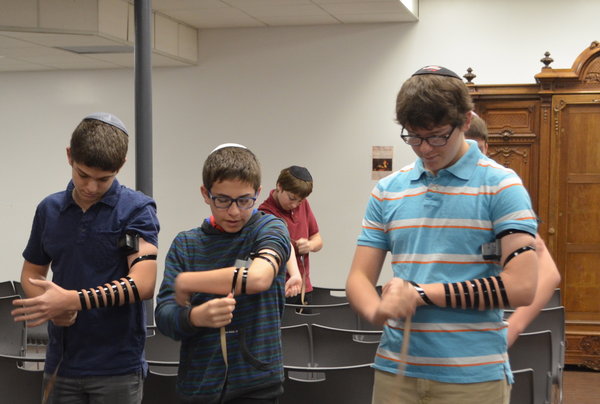Mother and daughter who sparked tefillin debate respond to Rabbi Segal’s decision
After a lively Town Hall debate on the subject, The Boiling Point reached out to the girl whose question started it all, an eighth-grader who eventually decided not to apply. She and her mother agreed to be interviewed but wanted to remain anonymous because of the girl’s age.

BOYS: Freshmen Zev Kent, Ezra Fax and Isaac Goor put on their tefillin at Shacharit.
November 17, 2013
Q: What do you and your daughter think of Rabbi Segal’s decision, which would have encouraged your daughter to use tefillin at home but not allowed it at Shalhevet?
A: I think that a lot of thoughts and care went into the decision. I felt that Rabbi Segal, just the fact that he brought the question to the community and did so in a respectful manner, is incredible. We are disappointed in the final decision but not really surprised.
Q: Did your daughter make her decision on where to apply based on the decision?
A: A big part of it was. She wants to be a rabbi. She’s known since she was nine years old and she’s been very connected to Judaism and Torah for her whole life. In a Conservative shul she has lived her whole life with women wearing tallit and tefillin. It is how she expresses herself and her Judaism, and how she feels connected to God.
Q: What is the reason your daughter is not applying?
A: She understood if she couldn’t read from the Torah that it wouldn’t be a dealbreaker, but especially the tallit, that would be the real dealbreaker.
Q: Does she put tefillin on at home?
A: She puts tefillin on when she davens at school. She wears the tallit on Shabbat morning, Kol Nidre, etcetera.
Q: Where did she get the idea to wrap tefillin?
A: Just the role models that she has had and she has seen. The first temple that she was ever at we had a female rabbi on weekdays who would wrap tefillin and wear a tallit. When we came to our shul, our cantor would wrap tefillin. It is something normal that she saw and she always had the role model of the clergy. Not all her classmates do it.
Q: What high school will your daughter go to hopefully?
A: Our original plan was to apply to Shalhevet and Milken and our public school, but now she is just applying to Milken. She wants to be a rabbi and she knows that Milken would be the best fit for her.
Q: What is your response to the boys who said it would disturb their praying?
A: Well, isn’t there a mechitza? I don’t understand how it would disturb his prayer. How would it disturb him if he can’t see it? It’s too bad, it’s just too bad for him that he does not have an open mind to see that it is an optional mitzvah for women.
Q: Why do you want to be anonymous?
A: I can’t even put my finger on it 100 percent why. My daughter is a minor and I just want to protect her privacy. She has a very big personality and people at her school know her and know what she is about. I don’t want her to be put in ridicule.
Daughter
Q: How do you feel when you put on tallit and tefillin?
A: I feel more connected to my prayers and to God.
Q: Why is it important to you to wear tallit and tefillin?
A: It’s important to me because it helps me stay more focused. There are a lot of distractions during tefillah [prayer].
Q: Do any other girls at your school put on a tallit and tefillin?
A: No.
Q: How do you feel being the only girl who wears tallit and tefillin?
A: I think it’s cool.
Related: Some variety in how Modern Orthodox schools see tefillin issue
Related: Girls will not wear tefillin at Shalhevet, Rabbi Segal decides
Related: Complete text of Rabbi Segal’s decision regarding girls wearing tefillin at Shalhevet
Related: Lively Town Hall debate explores whether girls should be allowed to wear tefillin at school
This story is part of coverage that won 2nd prize in the Boris Smolar Award for Excellence in Enterprise or Investigative Reporting of the 2014 Simon J. Rockower Awards, given by the American Jewish Press Association, in the category of newspapers with under 15,000 circulation. It also won the Grand Prize in Jewish Scholastic Journalism from the Jewish Scholastic Press Association.













